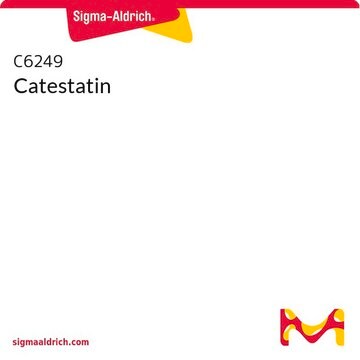All Photos(1)
About This Item
Empirical Formula (Hill Notation):
C72H116N18O24S1
Molecular Weight:
1649.86
UNSPSC Code:
12352200
NACRES:
NA.32
Recommended Products
Assay
≥95% (HPLC)
form
lyophilized
composition
Peptide Content, ≥68%
storage condition
protect from light
storage temp.
−20°C
Amino Acid Sequence
Trp-Ser-Lys-Met-Asp-Gln-Leu-Ala-Lys-Glu-Leu-Thr-Ala-Glu
Application
Chromogranin A (parathyroid secretory protein 1) is a precursor of the vasostatin, pancreastatin, catestatin, parastatin, chromostatin, GE-25 and WE-14. WE 14 is used to search for its as yet undefined physiological roles.
Storage Class Code
11 - Combustible Solids
WGK
WGK 3
Flash Point(F)
Not applicable
Flash Point(C)
Not applicable
Certificates of Analysis (COA)
Search for Certificates of Analysis (COA) by entering the products Lot/Batch Number. Lot and Batch Numbers can be found on a product’s label following the words ‘Lot’ or ‘Batch’.
Already Own This Product?
Find documentation for the products that you have recently purchased in the Document Library.
Per-Gøran Krüger et al.
Regulatory peptides, 114(1), 29-35 (2003-05-24)
Catestatin (bovine CgA(344-364)) is a cationic peptide, which besides reducing catecholamine secretion from chromaffin cells in vitro also acts a potent vasodilator in the rat in vivo. The alleged histamine releasing effect of catestatin was tested in vitro in rat
W J Curry et al.
Annals of the New York Academy of Sciences, 971, 311-316 (2002-11-20)
The neuropeptide WE-14 is derived from the posttranslational processing of chromogranin A (CgA). While CgA is expressed in a preponderance of neuroendocrine cells, WE-14 is generated in a distinct subpopulation of CgA-immunopositive cells, most notably in the adrenal, pituitary, and
William James Curry et al.
Microscopy research and technique, 62(5), 408-414 (2003-11-06)
WE-14 is generated in subpopulations of chromogranin A immunopositive endocrine cells and neurons including those innervating the anterior uvea. This study investigated WE-14 in intact sclero-limbo-corneal tissue from embryonic (E17), neonatal (N0-N16), and adult mice using immunocytochemistry and confocal scanning
Carmel Mary McVicar et al.
Regulatory peptides, 115(1), 1-10 (2003-07-23)
Immunohistochemical analysis of the male and female rat adenohypophysis revealed that chromogranin A (CgA), beta-granin and WE-14 immunostaining was localised to follicle stimulating hormone (FSH) producing cells, while luteinizing hormone (LH) producing cells exhibited chromogranin A and beta-granin immunostaining. The
The modulatory effects of WE-14 on histamine release from rat peritoneal mast cells.
P Forsythe et al.
Inflammation research : official journal of the European Histamine Research Society ... [et al.], 46 Suppl 1, S13-S14 (1997-03-01)
Our team of scientists has experience in all areas of research including Life Science, Material Science, Chemical Synthesis, Chromatography, Analytical and many others.
Contact Technical Service




